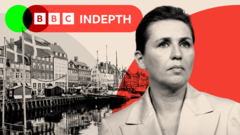As email and e-commerce reshape how we connect, the country's postal service adapts while fostering new opportunities.
**Denmark's Postal Evolution: A Shift Towards Digital Communication**

**Denmark's Postal Evolution: A Shift Towards Digital Communication**
Denmark announces the end of traditional letter deliveries, highlighting a growing trend of digitalization in communication.
In an unprecedented move, Denmark's renowned postal service, PostNord, is set to cease letter deliveries by the end of the year, a significant milestone marking the end of 400 years of letter service. This decision is prompted by a dramatic decline in letter volumes attributed to the digital transformation sweeping the globe. As PostNord's workforce shrinks by 2,200 positions, with the focus shifting to its more lucrative parcel delivery sector, the removal of around 1,500 classic red mailboxes is already underway.
Mail carrier Herman Moyano reflects on his experience: “I’ve noticed a substantial reduction in letters being delivered. These days, most of what I bring is just bills and bank statements.” On average, Danes receive just one letter per month—an indicator of a broader trend across Europe. Since 2000, the postal service has witnessed a staggering drop of over 90% in letter traffic, from approximately 1.4 billion letters annually to just 110 million last year, suggesting that this reduction in communication methods is not confined to Denmark.
Kim Pedersen, head of PostNord Denmark, explains, "People simply prefer shopping online." As Denmark champions a "digital by default" policy, its residents have embraced various electronic correspondence alternatives, significantly reducing their reliance on traditional mail. The high cost of postage has further exacerbated the situation, with the price of a stamp increasing to 29 Danish krone ($4.60), following changes to the postal market that have eliminated tax exemptions.
Such trends echo across Europe, where experts note that letter volumes have plummeted by up to 70% since 2008. The transitioning landscape has also triggered job cuts in other regions’ postal services, as evidenced by recent layoffs at Deutsche Post and changes in service frequency at the UK’s Royal Mail. Although today's society may be witnessing a decline in mainstream letter deliveries, it does not signify their total disappearance. New players like the private delivery firm DAO are stepping up to fill the void left by PostNord, ensuring mail reaches people in both urban and rural areas.
Meanwhile, some advocates, including DaneAge, express concern over the implications for vulnerable populations, particularly the elderly, who may struggle with fewer post office locations. Nevertheless, DAO assures that its services will efficiently connect all households, expanding their delivery capacity in response to increased demand for letters.
As Denmark's postal service faces this digital-heavy evolution, it unveils a broader picture of how societies adapt to advancing technology, highlighting both the challenges and potential solutions for maintaining communication in an increasingly digital era. However, as local resident Jette Eiring Williams illustrates, the emotional connection tied to handwritten letters still resonates with many, providing a balance to the fast pace of digital communication.
Mail carrier Herman Moyano reflects on his experience: “I’ve noticed a substantial reduction in letters being delivered. These days, most of what I bring is just bills and bank statements.” On average, Danes receive just one letter per month—an indicator of a broader trend across Europe. Since 2000, the postal service has witnessed a staggering drop of over 90% in letter traffic, from approximately 1.4 billion letters annually to just 110 million last year, suggesting that this reduction in communication methods is not confined to Denmark.
Kim Pedersen, head of PostNord Denmark, explains, "People simply prefer shopping online." As Denmark champions a "digital by default" policy, its residents have embraced various electronic correspondence alternatives, significantly reducing their reliance on traditional mail. The high cost of postage has further exacerbated the situation, with the price of a stamp increasing to 29 Danish krone ($4.60), following changes to the postal market that have eliminated tax exemptions.
Such trends echo across Europe, where experts note that letter volumes have plummeted by up to 70% since 2008. The transitioning landscape has also triggered job cuts in other regions’ postal services, as evidenced by recent layoffs at Deutsche Post and changes in service frequency at the UK’s Royal Mail. Although today's society may be witnessing a decline in mainstream letter deliveries, it does not signify their total disappearance. New players like the private delivery firm DAO are stepping up to fill the void left by PostNord, ensuring mail reaches people in both urban and rural areas.
Meanwhile, some advocates, including DaneAge, express concern over the implications for vulnerable populations, particularly the elderly, who may struggle with fewer post office locations. Nevertheless, DAO assures that its services will efficiently connect all households, expanding their delivery capacity in response to increased demand for letters.
As Denmark's postal service faces this digital-heavy evolution, it unveils a broader picture of how societies adapt to advancing technology, highlighting both the challenges and potential solutions for maintaining communication in an increasingly digital era. However, as local resident Jette Eiring Williams illustrates, the emotional connection tied to handwritten letters still resonates with many, providing a balance to the fast pace of digital communication.

















